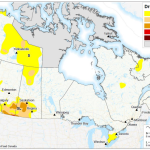MarketsFarm — The advancing Prairie harvest has seen an increase in farmer deliveries of grains and oilseeds into the commercial pipeline, according to the latest weekly data from the Canadian Grain Commission. Export activity for canola remains very light through the first six weeks of the 2022-23 crop year, but growing supplies in the commercial













